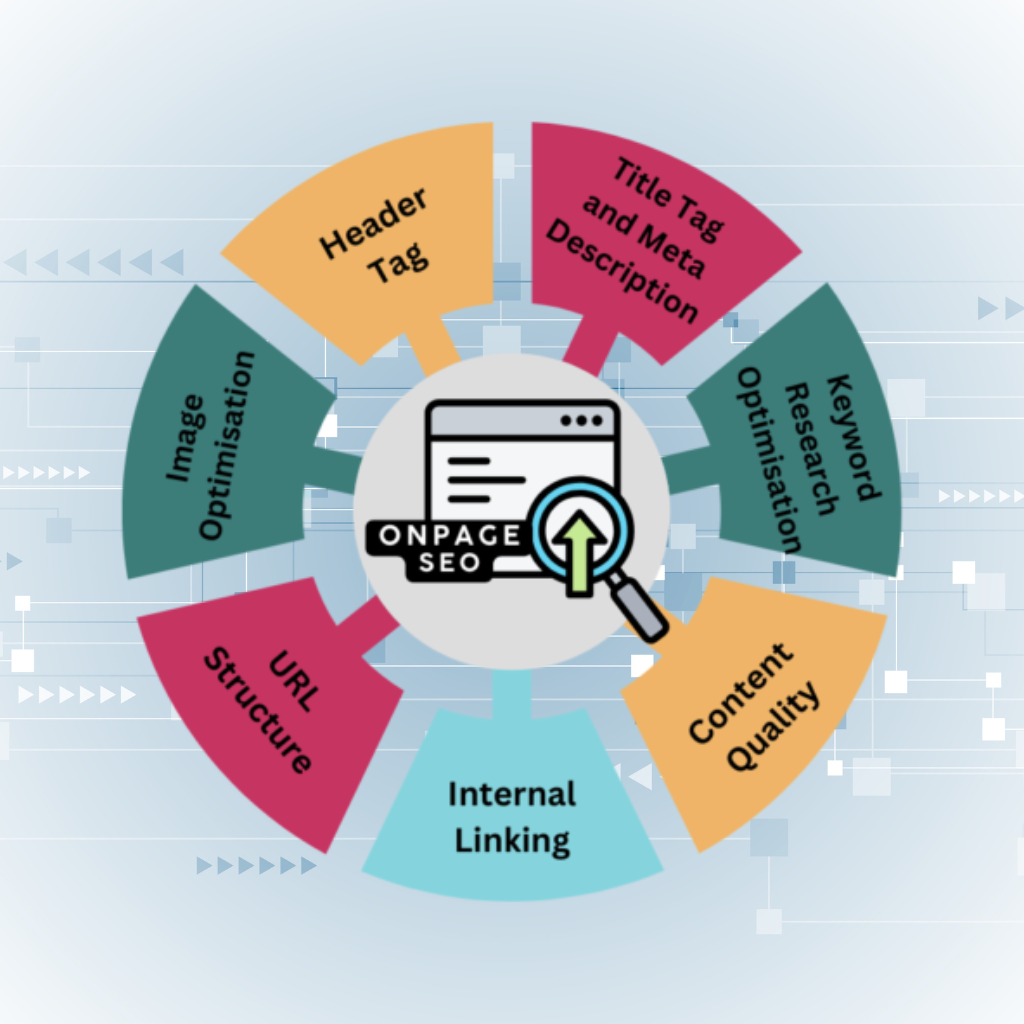On-Page SEO Essentials: Boost Your Rankings to No.1

Being ahead of the competition is essential in the dynamic realm of digital marketing. On-page SEO (Search Engine Optimization) is one of the best strategies to increase the visibility of your website and draw in natural visitors. Optimizing individual web pages to rank better and attract more relevant search engine traffic is known as on-page SEO. This thorough article will go over the key on-page SEO strategies that can improve user experience and raise your website’s ranks.
Understanding On-Page SEO
On-page SEO involves improving different components of a web page to raise its search engine ranks. You can directly influence on-page SEO elements, unlike off-page SEO, which focuses on external factors like backlinks. Examples include images, HTML tags, content, and website structure. By optimizing these elements, you can increase the appeal of your web pages to search engines and visitors alike.
1. Title Tags
The title tag is a crucial component of on-page SEO. It appears as the clickable headline for a result on search engine results pages (SERPs). A well-crafted title tag includes relevant keywords and is both concise and descriptive. To ensure proper display in the SERPs, keep your title tags between 50 and 60 characters.
Example: Instead of “Home,” use “Best Coffee Shop in New York | Freshly Brewed Coffee.”
2. Meta Descriptions
Meta descriptions provide a concise synopsis of a webpage’s content. Effective meta descriptions can increase click-through rates (CTR) by persuading readers to click on your link. Although they don’t directly affect search engine rankings, you should make sure your meta descriptions are between 150 and 160 characters long and contain pertinent keywords.
Example: “Discover the best coffee in New York City at our cozy coffee shop. Enjoy freshly brewed coffee, delicious pastries, and a warm atmosphere.”
3. Header Tags
Use header tags (H1, H2, H3, etc.) to better organize your material and make it easier for visitors and search engines to read. Use the H1 tag for the page’s primary heading, and H2 and H3 tags for subheadings. Enhance your on-page SEO by including pertinent keywords in your header tags.
Example: <h1>Best Coffee Shop in New York</h1>
<h2>Our Menu</h2>
<h3>Freshly Brewed Coffee</h3>
4. URL Structure
Both your on-page SEO and user experience can be improved with a clear and informative URL structure. Don’t use special characters or extraneous numbers; instead, use brief, informative URLs that contain pertinent keywords.
Example: Instead of “www.example.com/p=123,” use “www.example.com/best-coffee-shop-new-york.”
5. Content Quality
The foundation of successful on-page SEO is excellent content. Content that is interesting, educational, and pertinent to the user’s search query is given priority by search engines. Make sure your material is thoroughly researched, organically contains pertinent keywords, and benefits your readers. To fully cover themes, aim for longer content (at least 1,000 words).
Example: Write a detailed blog post on “The History of Coffee and Its Cultural Significance.”
6. Keyword Optimization
When it comes to on-page SEO, keywords are essential. To find pertinent terms and phrases that your target audience is searching for, do in-depth keyword research. Make strategic use of these keywords in the title, meta description, header tags, and body of your writing. Steer clear of keyword stuffing, as it might harm search engine rankings and user experience.
Example: Use variations of keywords like “best coffee shop,” “freshly brewed coffee,” and “New York coffee shop” throughout your content.
7. Internal Linking
Internal linking involves linking to other pages within your website. This practice helps search engines understand the structure of your site and improves navigation for users. Use descriptive anchor text that includes relevant keywords
Example: Link to a blog post about “The Different Types of Coffee Beans” within your main article about coffee.to enhance the SEO value of your internal links.
8. Image Optimization
Although images can greatly improve user experience, they must also be optimized for search engines. Make use of descriptive file names and include pertinent keywords to your images’ alt text. Reduce file size and speed up page loads by compressing photos.
Example: Instead of “IMG1234.jpg,” use “freshly-brewed-coffee.jpg” and include alt text like “Freshly brewed coffee in a ceramic mug.”
9. Mobile Friendliness
Google uses mobile-first indexing, so having a mobile-friendly website can help your search engine rankings. A mobile-friendly website is crucial for on-page SEO because mobile devices are becoming more and more common. Make sure your site is responsive, which means it adapts to different screen sizes and offers a smooth user experience on mobile devices. they must also be optimized for search engines. Make use of descriptive file names and include pertinent keywords to your images’ alt text. Reduce file size and speed up page loads by compressing photos.
10. Page Load Speed
In terms of user experience and SEO, page load speed is crucial. Pages that load slowly may have a high bounce rate and hurt your rankings. To find and address problems that can be slowing down your website, such as huge graphics, poorly optimized code, and server performance, use tools like Google PageSpeed Insights.
11. Schema Markup

One kind of structured data that aids search engines in comprehending the material on your website is schema markup. Rich snippets like star ratings, event details, and product details can be added to your search listings by incorporating schema markup into your HTML. By doing this, you can raise your site’s traffic and CTR.
Example: Use schema markup to display star ratings for customer reviews of your coffee shop.
12. User Experience (UX)
For on-page SEO, a satisfying user experience is essential. Make sure your website has an intuitive design, a clear layout, and easy navigation. Make use of understandable typefaces, a consistent color palette, and obvious calls to action. Longer visit durations, reduced bounce rates, and more engagement can result from offering a smooth and pleasurable user experience.
Conclusion
One crucial component of digital marketing that calls for constant work and improvement is on-page SEO. You can greatly improve the visibility and functionality of your website by concentrating on important components like title tags, meta descriptions, header tags, URL structure, content quality, keyword optimization, internal linking, image optimization, mobile friendliness, page load speed, schema markup, and user experience. You can remain ahead of the competition and accomplish your digital marketing objectives by putting these professional strategies into practice.
Related Articles
Stay Ahead of the Curve with GlowOn
Subscribe to our blog for more insights and strategies to help you navigate the future of digital marketing
Ready to Elevate Your Brand?
Let’s work together to create a marketing strategy that delivers results. Contact us today to get started




